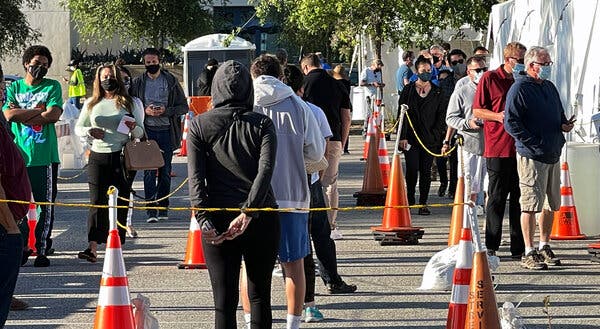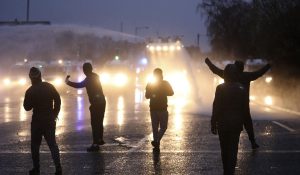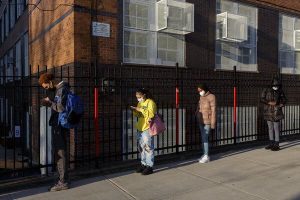Johnson & Johnson will allocate 86 percent fewer doses across the United States next week than are currently being allocated, according to data provided by the Centers for Disease Control and Prevention, dealing a setback to a national vaccination campaign that has just found its footing.
The distribution of the drug, a single-shot vaccine, has been inconsistent since Johnson & Johnson delivered its first batch at the beginning of March, sending 2.8 million doses across the country before dipping below 400,000 in the following weeks.
Last week about 1.9 million doses were sent across the country, and this week 4.9 million shots went out. Next week that number will drop to 700,000.
Federal administrators divide vaccine doses nationwide based on each state’s adult population. That means that California will bear the brunt of the reduction: After receiving 572,700 doses of the Johnson & Johnson vaccine this week, it will get only 67,600 next week.
In Texas, the allocation will drop to 46,300 from 392,100. Florida, which received 313,200 shots this week, will get 37,000 next week. Guam, which received 16,900 doses this week, will receive none next week.
The slowdown comes days after federal officials learned that Emergent BioSolutions, a contract manufacturer that has been making both the Johnson & Johnson and the AstraZeneca Covid-19 vaccines, had mixed up ingredients from the two. That mistake ruined up to 15 million doses of the Johnson & Johnson vaccine.
The mix-up also led regulators to delay authorization of the plant’s production lines and the Biden administration to put Johnson & Johnson in charge of the troubled Baltimore plant.
How big a role the problems at the Baltimore factory are playing in the fluctuations in the Johnson & Johnson vaccine distribution is difficult to determine.
Conservative about how many doses it would initially produce, Johnson & Johnson still fell behind this winter on its production goals in the U.S., delivering less than it had promised in February and March.
The initial Johnson & Johnson vaccine supply in the United States came from a Dutch plant and was delivered on an uneven schedule. That led the Biden administration to warn state health officials that the supply of the vaccine would be variable.
But federal officials expected that with the help of the Emergent factory in Baltimore, there would be a steady stream of doses from the company in April. Now, with that plant still lacking authorization, the anticipated delivery schedule is up in the air.
In Maryland, the state health secretary, Dennis R. Schrader, told vaccine providers that the “significant decrease with no advance notice is a surprise and a disappointment, and we share your frustration.” The state will receive 78,300 less shots next week compared with this week.
In Ohio, at his weekly news conference, Gov. Mike DeWine said he had been told that the reduction in doses was not a result of “what happened in the factory.” Ohio is to receive 151,600 fewer shots next week.
The C.D.C. said on Thursday that about 112 million people in the United States had received at least one dose of a vaccine, including about 66.2 million people who have been fully vaccinated by Johnson & Johnson’s single-dose vaccine or the two-dose series made by Pfizer-BioNTech and Moderna.

The coronavirus variant first detected in Britain is now spreading in at least 114 countries, and nowhere are its devastating effects as visible as in Europe, where thousands are dying each day and already-battered economies are being hit by new restrictions on daily life.
The variant, known as B.1.1.7, is not only more contagious than the virus’s initial form, but is also deadlier.
With the mutation now propelling a surge in cases in Europe — the epicenter of the pandemic last spring — an interactive article by The New York Times’s graphics team outlines the toll that the B.1.1.7 variant is taking on the continent, and lessons that it might offer the world.
Having surged in Britain starting in December, the variant also seeded outbreaks across the continent, but many went unnoticed behind an overall drop in cases. Those outbreaks have since ballooned, and B.1.1.7 has crowded out other versions of the virus, becoming dominant in more than a dozen European countries.
Despite watching the B.1.1.7 variant wallop Britain, lawmakers in continental Europe were slow to react. In late January, President Emmanuel Macron of France defied calls from his scientific advisers for new restrictions. Now, daily cases have doubled, hospitals are swelling with patients and Mr. Macron has imposed a third national lockdown.
“What’s surprising to me is how many countries didn’t anticipate what B.1.1.7 would bring,” said Devi Sridhar, a professor of global public health at the University of Edinburgh in Scotland. “People underestimated it, instead of saying we should learn from what’s happening in the U.K.”

The Hong Kong government said last month that it would allow hundreds of residents who have been stranded in Britain by virus-related travel restrictions to return on two special flights.
But when those residents went to book seats on flights, the website for Cathay Pacific Airways, Hong Kong’s flag carrier, crashed. The snafu on Thursday was the latest chapter in a bureaucratic saga that has left them feeling angry, confused and exasperated.
The Hong Kong government suspended flights from Britain in December as a coronavirus variant spread through that country. It also barred anyone who had spent more than two hours there or in other “extremely high-risk” places in the previous 21 days from boarding a direct flight to the Chinese territory.
Those measures, which remain in effect, also apply to inbound travelers who have recently been to Brazil, Ireland or South Africa. But last week Hong Kong said that it would arrange two special return flights from London on Cathay Pacific in late April. It cited Britain’s declining caseload and “satisfactory vaccination progress” as reasons for the policy shift.
When the airline’s website crashed on Thursday, said Anthony Sheik Bux, a district councilor in Hong Kong who has been helping the stranded travelers, “people panicked” and started contacting him.
In a statement on Friday, Cathay Pacific apologized for the glitch and said that roughly 600 seats on the two flights — scheduled for April 21 and April 28 — had sold out after the website problem was resolved.
The South China Morning Post newspaper reported last week that the travel ban had stranded more than 600 Hong Kong residents in Britain. Mr. Bux said on Friday that some of them had been unable to book seats on the special flights.
It was unclear whether additional flights would be offered, or why officials in Hong Kong, where the borders have been closed to nonresidents for more than a year, waited more than three months to schedule the two flights. A spokeswoman for the Immigration Department referred questions on Friday to the Food and Health Bureau, which did not immediately respond to a request for comment.
Mr. Bux said he could sympathize with the stranded travelers because he, too, had been stranded by the December ban while visiting family in Liverpool. He said he was among the 200 to 300 Hong Kong residents who had managed to make it home from Britain after spending a 21-day “wash out” period in a third country like Thailand, Egypt or the United Arab Emirates.
In Mr. Bux’s case, he flew to Bangkok on Feb. 7 and arrived home more than three weeks later — only to begin a mandatory three-week hotel quarantine, one of the world’s longest. Some scientists have questioned whether that policy is too strict because the coronavirus is widely considered to have a 14-day incubation period.
“After my departure from the U.K., I needed 42 days to resume my normal life in Hong Kong,” he said. “It’s a really long period.”

When it comes to getting a coronavirus vaccine, Mississippi residents have an abundance of options. On Thursday, there were more than 73,000 slots to be had on the state’s scheduling website, up from 68,000 on Tuesday.
In some ways, that growing availability of appointments is something to celebrate: It reflects the mounting supplies that have prompted states across the country to open up eligibility to anyone over 16. But public health experts say it also exposes something more worrisome: the large number of people who are reluctant to be inoculated.
“It’s time to do the heavy lifting needed to overcome the hesitancy we’re encountering,” said Dr. Obie McNair, an internal medicine practitioner in Jackson, the state capital.
Although access remains a problem in rural Mississippi, experts say that the state — which three weeks ago became one of the first to open eligibility to all adults — may be a harbinger of what much of the country will confront in the coming weeks as increasing supplies enable most Americans who want the vaccine to easily make appointments.
Demographics help explain Mississippi’s challenge. The state reliably votes Republican, a group that remains highly skeptical of coronavirus vaccines. And its population is 38 percent Black, a group that in one recent survey indicated a lower willingness to be vaccinated than Hispanic or white people.
The hesitancy has national implications. Experts say that 70 to 90 percent of people in the United States must be vaccinated for the country to reach herd immunity, the point at which the virus can no longer spread through the population.
In Mississippi, a quarter of all residents have received at least one vaccine dose, compared with the nationwide average of 33 percent, according to state data. Other Southern states, including Alabama, Arkansas, Georgia and Tennessee, have similarly low rates of vaccination.
Some other heavily Republican states are also finding themselves with surfeits of doses. Officials in Oklahoma, which has delivered at least one dose to 34 percent of its residents, said on Thursday that they would open up eligibility to out-of-state residents. In recent weeks, Republican governors in Ohio and Georgia voiced concern about lackluster vaccine demand among their residents.
Tim Callaghan, an assistant professor at the Texas A&M University School of Public Health and an expert on vaccine skepticism, said that more research was needed to determine the reasons behind Mississippi’s slackening vaccine demand, but that states with large rural populations, Republican voters and African-Americans were likely to be the first to confront the problem.
“If you’re looking to see vaccine hesitancy to emerge,” he said, “it’s going to be in red states like Mississippi.”



















